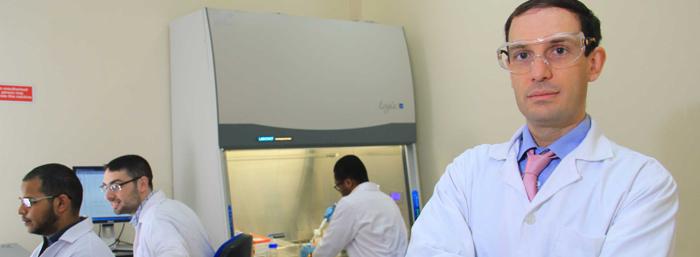- About
- Admissions
- Study at AUS
- Prospective Students
- Bachelor's Degrees
- Master's Degrees
- Doctoral Degrees
- Admission Publications
- International Students
- Contact Admissions
- Grants and Scholarships
- Sponsorship Liaison Services
- Testing Center
- New Student Guide
- File Completion
- New Student Orientation
- Payment Guide
- Executive Education
- Students with Disabilities
- Academics
- Life at AUS
- Research and Graduate Studies
- Contact Us
- Apply Now
- .

AUS researchers are developing targeted chemotherapy treatment
A team of researchers at American University of Sharjah (AUS) is developing a way to combat the harsh side effects of chemotherapy by using a more targeted treatment activated by ultrasound.
An extensively used treatment to fight cancer, chemotherapy, is plagued with several negative side effects, including hair loss, leukopenia (a decrease in white blood cells that compromises the immune system), and gastrointestinal problems (including nausea) in addition to others. This is primarily because of the non-specific nature of the treatment as the drug can kill normal and cancerous cells alike. To combat these side effects, Dr. Ghaleb A. Husseini, Professor of Chemical Engineering at AUS, established the "Ultrasound in Cancer Research Group" with a team of AUS students, faculty and visiting professors.
The team of researchers, working at the recently established Drug Delivery Laboratory at AUS using an internal Faculty Research Grant, is investigating the use of nanocapsules that will encapsulate the chemotherapeutic agent and prevent its interactions with healthy cells. Once the nanoparticle reaches the desired location, ultrasound is applied to release the chemotherapy drug directly to the cancer site, thus avoiding any interaction with the healthy cells in the body. This way, the adverse side effects of chemotherapy are minimized.
"We are all familiar with the adverse side effects of conventional chemotherapy. The high toxicity of potent chemotherapeutic drugs limits the therapeutic window in which they can be applied. This window can be expanded by controlling the drug delivery in both space and time such that non-targeted tissues are not adversely affected," said Dr. Husseini.
"Our group is using ultrasound to control the release of anti-neoplastic agents from nanocarriers in both time and space. These nano-vehicles include ligand-targeted polymeric micelles and liposomes. The potential benefits of such controlled chemotherapy compel a thorough investigation of the role of ultrasound and the mechanisms by which ultrasound accomplishes drug release and/or enhances drug potency, which is the focus of our drug delivery group," he added.
The team is actively seeking funds to complete the next phase of the research which is currently in the in vitro testing stage of the carriers against cancer cells in test tubes.

